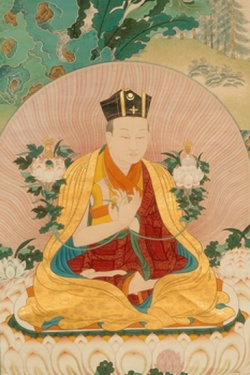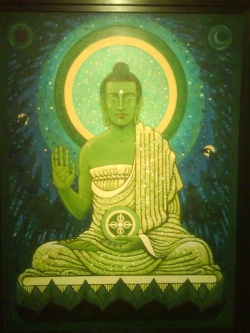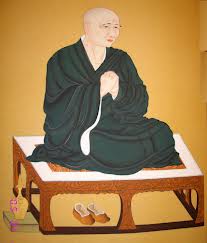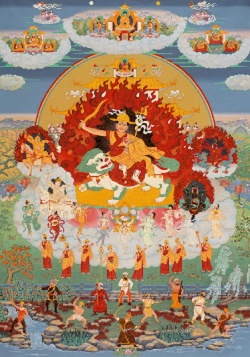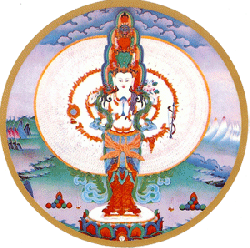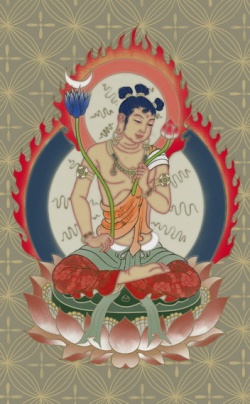Difference between revisions of "Calling the Lama from Afar"
m (Text replacement - "]]]" to "]])") |
|||
| Line 1: | Line 1: | ||
[[File:10541-1z.jpg|thumb|250px|]] | [[File:10541-1z.jpg|thumb|250px|]] | ||
| + | |||
| + | |||
| + | |||
| + | |||
| + | |||
| + | |||
==Calling the [[Lama]] from Afar by [[Pabongka Rinpoche]]== | ==Calling the [[Lama]] from Afar by [[Pabongka Rinpoche]]== | ||
[[Lama]], think of me.<br/> | [[Lama]], think of me.<br/> | ||
| Line 5: | Line 11: | ||
[[Lama]], think of me.<br/> | [[Lama]], think of me.<br/> | ||
| − | The [[Wisdom]] of great [[bliss]] of all [[Buddhas]], one {{Wiki|taste}} with the [[Dharmakaya]], is itself the ultimate nature of all kind [[lamas]]. I beseech you, [[Lama]], [[Dharmakaya]], please look after me always without separation, in this [[life]], {{Wiki|future}} [[lives]], and the [[Bardo]]. | + | The [[Wisdom]] of great [[bliss]] of all [[Buddhas]], one {{Wiki|taste}} with the [[Dharmakaya]], is itself the [[Wikipedia:Absolute (philosophy)|ultimate]] [[nature]] of all kind [[lamas]]. I beseech you, [[Lama]], [[Dharmakaya]], please look after me always without separation, in this [[life]], {{Wiki|future}} [[lives]], and the [[Bardo]]. |
| − | [[Wisdom]]’s own [[illusory]] [[appearance]], the [[conqueror]] with [[seven branches]], is itself the [[ultimate]] basis of [[emanation]] of all kind [[lamas]]. I beseech you, [[Lama]], [[sambhogakaya]], please look after me always without separation, in this [[life]], {{Wiki|future}} [[lives]], and the [[Bardo]]. | + | [[Wisdom]]’s [[own]] [[illusory]] [[appearance]], the [[conqueror]] with [[seven branches]], is itself the [[ultimate]] basis of [[emanation]] of all kind [[lamas]]. I beseech you, [[Lama]], [[sambhogakaya]], please look after me always without separation, in this [[life]], {{Wiki|future}} [[lives]], and the [[Bardo]]. |
The play of various [[emanations]], suiting the dispositions of the many to be subdued, is itself the {{Wiki|behavior}} of the [[sambhogakaya]] of the kind [[lamas]]. I beseech you, [[Lama]], [[nirmanakaya]], please look after me always without separation, in this [[life]], {{Wiki|future}} [[lives]], and the [[Bardo]]. | The play of various [[emanations]], suiting the dispositions of the many to be subdued, is itself the {{Wiki|behavior}} of the [[sambhogakaya]] of the kind [[lamas]]. I beseech you, [[Lama]], [[nirmanakaya]], please look after me always without separation, in this [[life]], {{Wiki|future}} [[lives]], and the [[Bardo]]. | ||
| Line 49: | Line 55: | ||
Therefore, [[Lama]], please bless me to generate in my [[mental]] {{Wiki|continuum}} effortless [[experience]] of the profound three {{Wiki|principles}} of the [[path]] and the two stages. | Therefore, [[Lama]], please bless me to generate in my [[mental]] {{Wiki|continuum}} effortless [[experience]] of the profound three {{Wiki|principles}} of the [[path]] and the two stages. | ||
| − | Please bless me to strive in one-pointed practice of the [[three trainings]] with the intense [[thought]] of [[renunciation]], in [[order]] to reach the secure state of [[liberation]]. | + | Please bless me to strive in [[one-pointed]] practice of the [[three trainings]] with the intense [[thought]] of [[renunciation]], in [[order]] to reach the secure [[state]] of [[liberation]]. |
Please bless me to train in the [[precious]] supreme [[Bodhichitta]] with the special [[attitude]] taking {{Wiki|responsibility}} to {{Wiki|liberate}} all migrators by myself alone. | Please bless me to train in the [[precious]] supreme [[Bodhichitta]] with the special [[attitude]] taking {{Wiki|responsibility}} to {{Wiki|liberate}} all migrators by myself alone. | ||
| Line 94: | Line 100: | ||
Please grant me [[blessings]] in this very session.<br/> | Please grant me [[blessings]] in this very session.<br/> | ||
| − | After reciting these verses, recite any requesting [[prayers]] to your own [[Guru]] that you wish. | + | After reciting these verses, recite any requesting [[prayers]] to your [[own]] [[Guru]] that you wish. |
May I not arise [[heresy]] even for a second<br/> | May I not arise [[heresy]] even for a second<br/> | ||
| Line 117: | Line 123: | ||
In general, there are two specific ways in which one can practice The [[Buddha]]'s teachings: | In general, there are two specific ways in which one can practice The [[Buddha]]'s teachings: | ||
| − | The first way is when the [[practitioner]] uses the [[Power]] of one's own {{Wiki|intelligence}}. One learns about the [[pure]] [[Dharma]], and afterward deeply [[contemplates]] its meaning and [[understands]] it. This is accomplished through years of meticulous study, so that an extensive [[understanding]] is acquired. Through this method, [[confidence]] is developed in the [[Dharma]]. The [[practitioner]] uses one's own {{Wiki|intelligence}} and [[discernment]] to [[recognize]] the right and accurate [[path]]; a {{Wiki|certainty}} and [[confidence]] unfolds which allows us to gradually [[meditate]], and then integrate the teachings into our own [[experience]]. | + | The first way is when the [[practitioner]] uses the [[Power]] of one's [[own]] {{Wiki|intelligence}}. One learns about the [[pure]] [[Dharma]], and afterward deeply [[contemplates]] its meaning and [[understands]] it. This is accomplished through years of meticulous study, so that an extensive [[understanding]] is acquired. Through this method, [[confidence]] is developed in the [[Dharma]]. The [[practitioner]] uses one's [[own]] {{Wiki|intelligence}} and [[discernment]] to [[recognize]] the right and accurate [[path]]; a {{Wiki|certainty}} and [[confidence]] unfolds which allows us to gradually [[meditate]], and then integrate the teachings into our [[own]] [[experience]]. |
The other possible way is to have deep conviction in the most important points of the [[Dharma]]; one [[understands]] and follows the basic teachings of The [[Buddha]] without failure. One is not [[ignorant]] or blindly following the [[Dharma]], since we must understand the teachings accurately. However, the [[practitioner]] does not go too deeply into study and [[contemplation]] regarding the teachings. Instead, one has [[confidence]] and turns towards [[meditation]] practice. It is then through [[meditation]] practice and actual [[experience]] that one develops all the inner [[understanding]] and [[knowledge]] of the [[Dharma]]. | The other possible way is to have deep conviction in the most important points of the [[Dharma]]; one [[understands]] and follows the basic teachings of The [[Buddha]] without failure. One is not [[ignorant]] or blindly following the [[Dharma]], since we must understand the teachings accurately. However, the [[practitioner]] does not go too deeply into study and [[contemplation]] regarding the teachings. Instead, one has [[confidence]] and turns towards [[meditation]] practice. It is then through [[meditation]] practice and actual [[experience]] that one develops all the inner [[understanding]] and [[knowledge]] of the [[Dharma]]. | ||
| − | Now, what is the connection or commonality that these two specific ways to practice, from which we choose between, have? They both [[aim]] at enabling the [[practitioner]] to understand the [[Buddhist]] [[view]] of the [[world]] and [[reality]]; this [[view]] is that the [[mind]] should develop true [[awareness]]. Even when studying, a [[Buddhist]] should not be [[attached]] to the mere words themselves. | + | Now, what is the [[connection]] or commonality that these two specific ways to practice, from which we choose between, have? They both [[aim]] at enabling the [[practitioner]] to understand the [[Buddhist]] [[view]] of the [[world]] and [[reality]]; this [[view]] is that the [[mind]] should develop true [[awareness]]. Even when studying, a [[Buddhist]] should not be [[attached]] to the mere words themselves. |
The [[Buddha]] said, "Do not be [[attached]] to the words themselves, but [[trust]] and understand the (true, inner) meaning." | The [[Buddha]] said, "Do not be [[attached]] to the words themselves, but [[trust]] and understand the (true, inner) meaning." | ||
| − | So, the we must first [[accomplish]] this state of [[awareness]]; if one is not {{Wiki|aware}} then [[nothing]] can possibly be accomplished in practice. For example, the [[principle]] [[insight]] gained by a [[Buddhist]] on the [[path]] is that [[worldly]] [[life]] and goals do not achieve anything ultimately; they have no {{Wiki|real}} meaning. However, if one has no [[awareness]] or [[Mindfulness]], one is just stuck on the words of this [[insight]]; one does not have any [[experience]] to understand the meaning of it (this profound [[insight]] about the [[selfless]] [[nature]] of [[worldly]] [[life]] will not be integrated into one's own [[experience]]). It becomes useless. | + | So, the we must first [[accomplish]] this [[state]] of [[awareness]]; if one is not {{Wiki|aware}} then [[nothing]] can possibly be accomplished in practice. For example, the [[principle]] [[insight]] gained by a [[Buddhist]] on the [[path]] is that [[worldly]] [[life]] and goals do not achieve anything ultimately; they have no {{Wiki|real}} meaning. However, if one has no [[awareness]] or [[Mindfulness]], one is just stuck on the words of this [[insight]]; one does not have any [[experience]] to understand the meaning of it (this profound [[insight]] about the [[selfless]] [[nature]] of [[worldly]] [[life]] will not be integrated into one's [[own]] [[experience]]). It becomes useless. |
| − | Therefore, one must hold onto this [[awareness]] for more than a fleeting moment. Once this [[awareness]] about the [[world]] is integrated into one's own [[experience]], then whenever a positive or negative situation (or [[action]]) arises, we will react properly and virtuously. We should [[recognize]] the [[true nature]] of our [[actions]]. [[Awareness]] is helpful to still all the [[disturbing emotions]], it is the basis for all practice and good-doing. | + | Therefore, one must hold onto this [[awareness]] for more than a fleeting [[moment]]. Once this [[awareness]] about the [[world]] is integrated into one's [[own]] [[experience]], then whenever a positive or negative situation (or [[action]]) arises, we will react properly and virtuously. We should [[recognize]] the [[true nature]] of our [[actions]]. [[Awareness]] is helpful to still all the [[disturbing emotions]], it is the basis for all practice and good-doing. |
[[File:Amoghavajra-478.jpg|thumb|250px|]] | [[File:Amoghavajra-478.jpg|thumb|250px|]] | ||
In [[Tibetan]], we say [[meditation]] is not merely just sitting down, it is not just "[[meditation]]." This {{Wiki|sounds}} like a wordplay, but it simply means that [[meditation]] is not just this; true [[meditation]] is when we become accustomed or more closely {{Wiki|aware}} of the [[truth]], to be {{Wiki|aware}} throughout one's entire [[experience]]. | In [[Tibetan]], we say [[meditation]] is not merely just sitting down, it is not just "[[meditation]]." This {{Wiki|sounds}} like a wordplay, but it simply means that [[meditation]] is not just this; true [[meditation]] is when we become accustomed or more closely {{Wiki|aware}} of the [[truth]], to be {{Wiki|aware}} throughout one's entire [[experience]]. | ||
| − | When we practice [[meditation]], one can focus the [[mind]] on different [[objects]]. But, this is not really the goal of [[meditation]]. The point is what develops out of this [[single-pointed]] [[concentration]] of the [[mind]], which is the basis of [[awareness]] integrated into our own [[experience]]. | + | When we practice [[meditation]], one can focus the [[mind]] on different [[objects]]. But, this is not really the goal of [[meditation]]. The point is what develops out of this [[single-pointed]] [[concentration]] of the [[mind]], which is the basis of [[awareness]] integrated into our [[own]] [[experience]]. |
| − | So, [[meditation]] is not only just a phase of sitting down and [[meditating]], it is really about using [[awareness]] everyday, every moment. Usually our [[awareness]] is disturbed and becomes uncontrolled due to {{Wiki|distractions}} created by the five [[sense organs]]. Once [[awareness]] is there, {{Wiki|distraction}} cannot be spoken of. True [[meditation]] is not merely sitting or {{Wiki|concentrating}} on something special, that is just the method to develop the {{Wiki|real}} practice of [[holding]] onto [[awareness]]. | + | So, [[meditation]] is not only just a phase of sitting down and [[meditating]], it is really about using [[awareness]] everyday, every [[moment]]. Usually our [[awareness]] is disturbed and becomes uncontrolled due to {{Wiki|distractions}} created by the five [[sense organs]]. Once [[awareness]] is there, {{Wiki|distraction}} cannot be spoken of. True [[meditation]] is not merely sitting or {{Wiki|concentrating}} on something special, that is just the method to develop the {{Wiki|real}} practice of [[holding]] onto [[awareness]]. |
Once this true [[meditation]] is there, one realizes that out of our [[mind]] (or [[consciousness]]) a continuous {{Wiki|stream}} of [[thoughts]] emerge. This fact alone demonstrates that the [[mind's]] [[true nature]] is [[emptiness]] and clarity. Through [[awareness]], one comes to carefully study the [[consciousness]]. We see directly that it is [[emptiness]]; one cannot find it or hold on any aspect or [[thought]]! Through [[awareness]], one sees the different [[thoughts]] going and coming, one [[recognizes]] the clarity of the [[mind]] this way. [[Emptiness]] and clarity are the clear aspects of the [[mind]] or [[consciousness]]. | Once this true [[meditation]] is there, one realizes that out of our [[mind]] (or [[consciousness]]) a continuous {{Wiki|stream}} of [[thoughts]] emerge. This fact alone demonstrates that the [[mind's]] [[true nature]] is [[emptiness]] and clarity. Through [[awareness]], one comes to carefully study the [[consciousness]]. We see directly that it is [[emptiness]]; one cannot find it or hold on any aspect or [[thought]]! Through [[awareness]], one sees the different [[thoughts]] going and coming, one [[recognizes]] the clarity of the [[mind]] this way. [[Emptiness]] and clarity are the clear aspects of the [[mind]] or [[consciousness]]. | ||
| Line 139: | Line 145: | ||
If there is this clarity and [[emptiness]], there should not be any fault in the [[mind]]. But, then, how does {{Wiki|confusion}} arise? {{Wiki|Confusion}} arises when one does not [[know]] or understand what the clear aspect of the [[mind]] is about. One runs after [[thoughts]] and tries to possess them, one attempts to describe the [[mind]] with words and {{Wiki|expressions}}, and gets stuck on [[ideas]] and [[beliefs]]; this is what brings forth {{Wiki|real}} {{Wiki|confusion}}! | If there is this clarity and [[emptiness]], there should not be any fault in the [[mind]]. But, then, how does {{Wiki|confusion}} arise? {{Wiki|Confusion}} arises when one does not [[know]] or understand what the clear aspect of the [[mind]] is about. One runs after [[thoughts]] and tries to possess them, one attempts to describe the [[mind]] with words and {{Wiki|expressions}}, and gets stuck on [[ideas]] and [[beliefs]]; this is what brings forth {{Wiki|real}} {{Wiki|confusion}}! | ||
| − | [[Awareness]] must then be counted on; it is needed so that the clear aspect is fully seen, so that the [[practitioner]] does not run after the notional process which ends in {{Wiki|confusion}}. [[Awareness]] leads to [[seeing]] the clarity and [[emptiness]] of the [[mind]]. What leads to this [[awareness]] and [[understanding]]? First we study, and then [[contemplate]] the teachings, and then [[meditate]]; we rely on these methods to [[accomplish]] our task of gaining true [[awareness]]. | + | [[Awareness]] must then be counted on; it is needed so that the clear aspect is fully seen, so that the [[practitioner]] does not run after the notional process which ends in {{Wiki|confusion}}. [[Awareness]] leads to [[seeing]] the clarity and [[emptiness]] of the [[mind]]. What leads to this [[awareness]] and [[understanding]]? First we study, and then [[contemplate]] the teachings, and then [[meditate]]; we rely on these [[methods]] to [[accomplish]] our task of gaining true [[awareness]]. |
However, this entire task of gaining [[awareness]] has preconditions. To develop this sort of [[Wisdom]], one needs a [[spiritual]] [[friend]]. The need for a [[spiritual]] [[friend]] has different meanings within the [[Three Vehicles]] ([[yanas]]) of [[Buddhism]]; the role of the [[spiritual]] [[friend]] is different for the various [[lineages]] and [[vehicles]] of [[Buddhism]]. | However, this entire task of gaining [[awareness]] has preconditions. To develop this sort of [[Wisdom]], one needs a [[spiritual]] [[friend]]. The need for a [[spiritual]] [[friend]] has different meanings within the [[Three Vehicles]] ([[yanas]]) of [[Buddhism]]; the role of the [[spiritual]] [[friend]] is different for the various [[lineages]] and [[vehicles]] of [[Buddhism]]. | ||
| Line 155: | Line 161: | ||
But the [[root]] [[Guru]] uses both words and the whole {{Wiki|environment}} to express the [[Buddhadharma]]; his entire expression [[influences]] the [[practitioner]]. So, one can effectively use the teachings in one's [[life]] and the [[practitioner]] can be guided to [[recognize]] the [[true nature]] of the [[mind]], the clear aspect of the [[mind]]. It is important to know that the [[root]] [[Guru]] is the one who enables the [[practitioner]] to see the [[nature]] of the [[mind]]. That is why one must develop a genuine relationship with a [[root]] [[Guru]]. | But the [[root]] [[Guru]] uses both words and the whole {{Wiki|environment}} to express the [[Buddhadharma]]; his entire expression [[influences]] the [[practitioner]]. So, one can effectively use the teachings in one's [[life]] and the [[practitioner]] can be guided to [[recognize]] the [[true nature]] of the [[mind]], the clear aspect of the [[mind]]. It is important to know that the [[root]] [[Guru]] is the one who enables the [[practitioner]] to see the [[nature]] of the [[mind]]. That is why one must develop a genuine relationship with a [[root]] [[Guru]]. | ||
| − | In the beginning of such a relationship, the [[practitioner]] should develop a deep [[sense]] of [[devotion]] and [[respect]] towards all his [[actions]]. His [[actions]] [[guide]] our [[mind]] to [[understanding]] and to a positive state; his [[actions]] {{Wiki|liberate}} our [[consciousness]]. We deeply [[trust]] the [[Guru]], [[knowing]] that all of his [[actions]] [[guide]] us the right way. | + | In the beginning of such a relationship, the [[practitioner]] should develop a deep [[sense]] of [[devotion]] and [[respect]] towards all his [[actions]]. His [[actions]] [[guide]] our [[mind]] to [[understanding]] and to a positive [[state]]; his [[actions]] {{Wiki|liberate}} our [[consciousness]]. We deeply [[trust]] the [[Guru]], [[knowing]] that all of his [[actions]] [[guide]] us the right way. |
One must not simply have [[trust]] in the [[root]] [[Guru]] as a [[thought]], this must spontaneously arise from inside oneself. [[Devotion]] is not [[imagined]]! It never changes, it is {{Wiki|stable}}, it stays within you. Once this is developed, there is a true [[sense]] of [[devotion]] and [[confidence]] that arises spontaneously. One [[understands]] that the [[Root]] [[Guru]] and the [[Buddha Shakyamuni]] are not different, one does not serve the two of them differently. | One must not simply have [[trust]] in the [[root]] [[Guru]] as a [[thought]], this must spontaneously arise from inside oneself. [[Devotion]] is not [[imagined]]! It never changes, it is {{Wiki|stable}}, it stays within you. Once this is developed, there is a true [[sense]] of [[devotion]] and [[confidence]] that arises spontaneously. One [[understands]] that the [[Root]] [[Guru]] and the [[Buddha Shakyamuni]] are not different, one does not serve the two of them differently. | ||
| Line 170: | Line 176: | ||
Out of this [[understanding]], based on the relationship of [[Naropa]] and [[Marpa]], did the [[Kagyu]] [[Tradition]] develop. This example from the relationship of [[Naropa]] and [[Marpa]] was meant to bring [[understanding]]: one must [[trust]] and have [[confidence]] in the [[activity]] of the [[Lama]]. The [[Lama]] and The [[Buddha]] are inseparably connected; they are indistinguishable! | Out of this [[understanding]], based on the relationship of [[Naropa]] and [[Marpa]], did the [[Kagyu]] [[Tradition]] develop. This example from the relationship of [[Naropa]] and [[Marpa]] was meant to bring [[understanding]]: one must [[trust]] and have [[confidence]] in the [[activity]] of the [[Lama]]. The [[Lama]] and The [[Buddha]] are inseparably connected; they are indistinguishable! | ||
| − | This [[devotion]] must be more than a [[thought]]; [[trust]] in the [[Guru]] should be like [[Marpa's]] {{Wiki|reaction}} to the [[appearance]] of [[Hevajra]]. At the moment [[Hevajra]] appeared, true conviction and [[respect]] spontaneously arose out of [[Marpa]]. | + | This [[devotion]] must be more than a [[thought]]; [[trust]] in the [[Guru]] should be like [[Marpa's]] {{Wiki|reaction}} to the [[appearance]] of [[Hevajra]]. At the [[moment]] [[Hevajra]] appeared, true conviction and [[respect]] spontaneously arose out of [[Marpa]]. |
This spontaneous and [[unchanging]] [[devotion]] must come out from inside, it is what makes the [[activity]] of the [[teacher]] special. This [[devotion]] is what makes [[Vajrayana]] special and expedient. This [[devotion]], which [[causes]] one to see the [[Lama]] and The [[Buddha]] as [[inseparable]], is what awakens one's inner potential; it allows us to {{Wiki|liberate}} our [[mind]] and see our [[true nature]], [[Buddha-nature]], directly. | This spontaneous and [[unchanging]] [[devotion]] must come out from inside, it is what makes the [[activity]] of the [[teacher]] special. This [[devotion]] is what makes [[Vajrayana]] special and expedient. This [[devotion]], which [[causes]] one to see the [[Lama]] and The [[Buddha]] as [[inseparable]], is what awakens one's inner potential; it allows us to {{Wiki|liberate}} our [[mind]] and see our [[true nature]], [[Buddha-nature]], directly. | ||
| Line 178: | Line 184: | ||
For [[awareness]] to develop, the [[teacher]] is needed; his or her guidance and inspiration is of such great important. | For [[awareness]] to develop, the [[teacher]] is needed; his or her guidance and inspiration is of such great important. | ||
| − | There are several methods for gaining [[confidence]] in the [[teacher]], such as practicing [[Guru]] [[Yoga]], or using the [[prayer]] titled, "Calling the [[Lama]] from Afar," which is the topic of this [[teaching]] seminar. | + | There are several [[methods]] for gaining [[confidence]] in the [[teacher]], such as practicing [[Guru]] [[Yoga]], or using the [[prayer]] titled, "Calling the [[Lama]] from Afar," which is the topic of this [[teaching]] seminar. |
Practice is the way one works to develop [[devotion]] to the [[Guru]]. Once [[realization]] is gained, the [[student]] will understand that there is no such thing as calling the [[Lama]] from afar. | Practice is the way one works to develop [[devotion]] to the [[Guru]]. Once [[realization]] is gained, the [[student]] will understand that there is no such thing as calling the [[Lama]] from afar. | ||
| Line 190: | Line 196: | ||
So, in the [[mind]] of the [[Lama]] these three aspects of The [[Buddha]] are completely there. There is [[nothing]] in which the [[mind]] of the [[Lama]] does not pervade, all the [[appearances]] of the [[teacher]] are there. | So, in the [[mind]] of the [[Lama]] these three aspects of The [[Buddha]] are completely there. There is [[nothing]] in which the [[mind]] of the [[Lama]] does not pervade, all the [[appearances]] of the [[teacher]] are there. | ||
| − | Although the [[Lama]] is really pervading everywhere and is [[inseparable]] from one's own [[mind]], the [[student]] usually is not {{Wiki|aware}} of that. The [[practitioner]] does not realize this; one does not [[know]] that his confused [[mind]] (in its [[ultimate]] [[essence]], the [[mind's]] [[nature]]) is just like the [[mind]] of the [[Lama]] (which has [[emptiness]] and clarity). This is why the [[student]] must call the [[Lama]] from afar. | + | Although the [[Lama]] is really pervading everywhere and is [[inseparable]] from one's [[own]] [[mind]], the [[student]] usually is not {{Wiki|aware}} of that. The [[practitioner]] does not realize this; one does not [[know]] that his confused [[mind]] (in its [[ultimate]] [[essence]], the [[mind's]] [[nature]]) is just like the [[mind]] of the [[Lama]] (which has [[emptiness]] and clarity). This is why the [[student]] must call the [[Lama]] from afar. |
| − | The [[mind]] of the [[Lama]] is not different from our own in its [[ultimate]] [[essence]] or clear aspect. But since we have, from [[time]] without beginning, wandered in [[Samsara]] and circled through [[endless]] [[rebirths]], we call upon the [[Lama]]. That is the [[reason]] why we call the [[Lama]] from afar. | + | The [[mind]] of the [[Lama]] is not different from our [[own]] in its [[ultimate]] [[essence]] or clear aspect. But since we have, from [[time]] without beginning, wandered in [[Samsara]] and circled through [[endless]] [[rebirths]], we call upon the [[Lama]]. That is the [[reason]] why we call the [[Lama]] from afar. |
| − | The goal of calling the [[Lama]] from afar is to realize that everything is only the expression, [[manifestation]], play and [[mind]] of the [[Lama]], or the [[nature]] of one's own [[mind]] ([[Buddha nature]] which is the clear aspect). This is the {{Wiki|real}} meaning of calling the [[Lama]] from afar. | + | The goal of calling the [[Lama]] from afar is to realize that everything is only the expression, [[manifestation]], play and [[mind]] of the [[Lama]], or the [[nature]] of one's [[own]] [[mind]] ([[Buddha nature]] which is the clear aspect). This is the {{Wiki|real}} meaning of calling the [[Lama]] from afar. |
<[[Rinpoche]] bestows the oral transmission for text, so that students can then practice what has been taught. Specific practices of [[Guru]] Yoga are given by lineage teachers to the students.> | <[[Rinpoche]] bestows the oral transmission for text, so that students can then practice what has been taught. Specific practices of [[Guru]] Yoga are given by lineage teachers to the students.> | ||
| Line 200: | Line 206: | ||
Question: Can [[space]] be used to explain [[emptiness]]? When we talk about [[emptiness]], it is very {{Wiki|theoretical}}. So, can [[space]] be used as a {{Wiki|metaphor}} for [[emptiness]]? | Question: Can [[space]] be used to explain [[emptiness]]? When we talk about [[emptiness]], it is very {{Wiki|theoretical}}. So, can [[space]] be used as a {{Wiki|metaphor}} for [[emptiness]]? | ||
| − | [[His Eminence]]: [[Space]] can be used as an example. [[Space]], like [[emptiness]], is all pervading. Everything emerges out of the [[empty]] [[nature]] of the [[mind]], just like [[space]]. However, the {{Wiki|concept}} of [[emptiness]] in The [[Buddha]]'s teachings is not [[nothingness]]. It is not just something we can point at and say "This is it." [[Emptiness]] is an [[understanding]] which must be developed within one's own [[mind]]. | + | [[His Eminence]]: [[Space]] can be used as an example. [[Space]], like [[emptiness]], is all pervading. Everything emerges out of the [[empty]] [[nature]] of the [[mind]], just like [[space]]. However, the {{Wiki|concept}} of [[emptiness]] in The [[Buddha]]'s teachings is not [[nothingness]]. It is not just something we can point at and say "This is it." [[Emptiness]] is an [[understanding]] which must be developed within one's [[own]] [[mind]]. |
Question: Does the {{Wiki|concept}} of a [[self]] then also come out of [[emptiness]]? | Question: Does the {{Wiki|concept}} of a [[self]] then also come out of [[emptiness]]? | ||
| Line 217: | Line 223: | ||
Glorious [[Lama]], please bless me to recall [[death]] and [[impermanence]] sincerely. <br/> | Glorious [[Lama]], please bless me to recall [[death]] and [[impermanence]] sincerely. <br/> | ||
Glorious [[Lama]], please bless me to generate [[contentment]] within myself.<br/> | Glorious [[Lama]], please bless me to generate [[contentment]] within myself.<br/> | ||
| − | Glorious [[Lama]], please bless me to dwell in isolation in one-pointed practice. <br/> | + | Glorious [[Lama]], please bless me to dwell in isolation in [[one-pointed]] practice. <br/> |
Glorious [[Lama]], please bless me to be free of any interruption to my practice. <br/> | Glorious [[Lama]], please bless me to be free of any interruption to my practice. <br/> | ||
Glorious [[Lama]], please bless me so that all bad [[conditions]] appear as helpers. <br/> | Glorious [[Lama]], please bless me so that all bad [[conditions]] appear as helpers. <br/> | ||
| − | Glorious [[Lama]], please bless me to spontaneously achieve my own and other's {{Wiki|welfare}}. <br/> | + | Glorious [[Lama]], please bless me to spontaneously achieve my [[own]] and other's {{Wiki|welfare}}. <br/> |
Please bless me now quickly. Please bless me very quickly. <br/> | Please bless me now quickly. Please bless me very quickly. <br/> | ||
Please bless me on this very cushion. Please bless me in this very session! | Please bless me on this very cushion. Please bless me in this very session! | ||
Latest revision as of 09:55, 15 March 2024
Calling the Lama from Afar by Pabongka Rinpoche
Lama, think of me.
Lama, think of me.
Lama, think of me.
The Wisdom of great bliss of all Buddhas, one taste with the Dharmakaya, is itself the ultimate nature of all kind lamas. I beseech you, Lama, Dharmakaya, please look after me always without separation, in this life, future lives, and the Bardo.
Wisdom’s own illusory appearance, the conqueror with seven branches, is itself the ultimate basis of emanation of all kind lamas. I beseech you, Lama, sambhogakaya, please look after me always without separation, in this life, future lives, and the Bardo.
The play of various emanations, suiting the dispositions of the many to be subdued, is itself the behavior of the sambhogakaya of the kind lamas. I beseech you, Lama, nirmanakaya, please look after me always without separation, in this life, future lives, and the Bardo.
The play of the inseparable three kayas, appearing in the form of the Lama, is itself one with the very essence of all kind lamas. I beseech you, Lama, the inseparable three kayas, please look after me always without separation, in this life, future lives, and the Bardo.
All the infinite peaceful and wrathful yidams are also the Lama’s nature, and since no yidam exists apart from the kind Lama himself, I beseech you, Lama, who comprises all yidams, please look after me always without separation, in this life, future lives, and the Bardo.
The ordinary form of all Buddhas arises in the aspect of the Lama, therefore no Buddhas are observed apart from the kind Lama himself. I beseech you, Lama, who comprises all Buddhas, please look after me always without separation, in this life, future lives, and the Bardo.
The very form of all conquerors’ Wisdom, compassion, and Power arises as the Lama, therefore the supreme Arya lords of the three families are also the kind Lama himself. I beseech you, Lama, who combines three families in one, please look after me always without separation, in this life, future lives, and the Bardo.
The hundred, five, and three families, however many elaborated, are the Lama. The pervasive master himself in whom they are all included is also the Lama. I beseech you, Lama, as master of all the families, please look after me always without separation, in this life, future lives, and the Bardo.
The creator of all Buddhas, Dharma, and Sangha is the Lama. The one who combines all three refuges is the kind Lama himself. I beseech you, Lama, whose presence combines all refuges, please look after me always without separation, in this life, future lives, and the Bardo.
Thinking of how the actual form of all Buddhas arises in the aspect of the Lama and mercifully looks after me – reminds me of you, Lama.
Thinking of how you show the excellent unmistaken path to me, an unfortunate wretched being, abandoned by all the Buddhas – reminds me of you, Lama.
Thinking of this excellent body, highly meaningful and difficult to obtain, and wishing to take its essence with unerring choice between gain and loss, happiness and Suffering – reminds me of you, Lama.
Thinking of the experience of not knowing what to do when the great fear of death suddenly descends upon me – reminds me of you, Lama.
Thinking of the experience of just now suddenly separating from all the perfections of this life, and going on alone – reminds me of you, Lama.
Thinking of the experience of my naked body falling into the terrifying fires of hell and being unable to bear it – reminds me of you, Lama.
Thinking of how the Suffering of hunger and thirst, without a drop of water, is directly experienced in the unfortunate preta realm – reminds me of you, Lama.
Thinking of how very repulsive and wretched it is to become a foolish stupid animal and what it would be like to experience it myself – reminds me of you, Lama.
Thinking of a Refuge to protect me from this, since I am now about to fall into the wretched states of bad migration – reminds me of you, Lama.
Thinking of how white and black actions are experienced and of how to practice thorough and precise engagement and restraint – reminds me of you, Lama.
Thinking of a method to escape this prison of endless existences, the source of all Suffering – reminds me of you, Lama.
Thinking of the plight of my pitiful old mothers, pervasive as space, fallen amidst the fearful ocean of Samsara and tormented there – reminds me of you, Lama.
Therefore, Lama, please bless me to generate in my mental continuum effortless experience of the profound three principles of the path and the two stages.
Please bless me to strive in one-pointed practice of the three trainings with the intense thought of renunciation, in order to reach the secure state of liberation.
Please bless me to train in the precious supreme Bodhichitta with the special attitude taking responsibility to liberate all migrators by myself alone.
Please bless me to follow after the ocean of conquerors with the will to cross to the very end of the great waves of deeds of the conquerors’ children.
Please bless me to realize the supreme view, free of extremes, in which emptiness and Dependent arising, appearance and emptiness, complement each other.
Please bless me quickly to generate the experience of taking The Three Kayas into the path, ripening the bases of birth, death, and Bardo.
Please bless me to arise as the illusory divine body itself, the play of the four joys and four emptinesses when the wind and mind absorb in the central channel.
Please bless me to meet the ultimate Lama – the bare face of my innate mind with the covering of perception (of true existence) and perceiving (it as true) removed.
Please bless me to be one with your three secrets, Lama, in the vast Dharmakaya of great bliss, which has exhausted the elaborations of the two obscurations.
In short, please abide inseparably in the center of my heart until the great Enlightenment, and mercifully bless me, the child, to follow after you, the father.
Lama, think of me.
Lama, think of me.
Lama, think of me.
Calling the Lama From Afar
Abbreviated Version
Lama, think of me!
Lama, think of me!
Lama, think of me!
Magnificently glorious Guru, dispelling the darkness of ignorance;
Magnificently glorious Guru, revealing the path of liberation;
Magnificently glorious Guru, liberating from the waters of Samsara;
Magnificently glorious Guru, eliminating the diseases of the five poisons;
Magnificently glorious Guru who is the wish-granting jewel;
I beseech you:
Please grant me blessings to remember impermanence and death from my heart
And to generate the thought of no-need in my mind.
Magnificently glorious Guru, please bless me to abide one-pointedly in practice in isolated places, not having any hindrances to my practice.
Magnificently glorious Guru, please bless me so that all bad conditions appear encouraging.
Magnificently glorious Guru, please bless me to accomplish effortlessly the two works of self and others.
Magnificently glorious Guru, please bless me soon, very soon.
Please grant me blessings on this very cushion.
Please grant me blessings in this very session.
After reciting these verses, recite any requesting prayers to your own Guru that you wish.
May I not arise heresy even for a second
In the actions of the glorious Guru.
May I regard whatever actions are done as pure.
[With this devotion) may I receive the blessings of the Guru in my heart.
Then recite the following verse and meditate on the Guru entering your heart.
Magnificent and precious root Guru,
Please abide on the lotus and moon seat at my heart.
Guide me with your great kindness,
And grant me the realizations of your holy body, speech, and mind.
Colophon for the short version: Author unknown. Translated by Lama Zopa Rinpoche in 1985. Transcribed and edited by Ven. Thubten Dondrub. The two final verses following the main prayer were also translated by Lama Zopa Rinpoche. Lightly edited by Ven. Constance Miller, FPMT Education Department, January 1999.
Calling the Lama from Afar by His Eminence the 3rd Jamyan Kongtrul Rinpoche
What we presently call Buddhism arose out of India; the Buddha Shakyamuni originally taught there and his Dharma teachings spread from there. Later on in history, it was possible for The Buddha's teaching to arrive in Tibet. This was due to inviting skillful translators, teachers and other accomplished beings. These masters who came to Tibet translated all of The Buddha's original words and teachings into the Tibetan language. Likewise, all the commentaries (which explain the Dharma) available at the time, authored by Indian masters, were translated into Tibetan. Over time, even the great scholars and accomplished yogis of Tibet wrote commentaries on the basis of The Buddha's words as recorded in the scriptures.
Through these efforts, all the teachings of the Buddha Shakyamuni which include the view, the path of meditation and the fruition of realization spread and disseminated. This enabled Buddhist to practice the spoken words of The Buddha.
In general, there are two specific ways in which one can practice The Buddha's teachings:
The first way is when the practitioner uses the Power of one's own intelligence. One learns about the pure Dharma, and afterward deeply contemplates its meaning and understands it. This is accomplished through years of meticulous study, so that an extensive understanding is acquired. Through this method, confidence is developed in the Dharma. The practitioner uses one's own intelligence and discernment to recognize the right and accurate path; a certainty and confidence unfolds which allows us to gradually meditate, and then integrate the teachings into our own experience.
The other possible way is to have deep conviction in the most important points of the Dharma; one understands and follows the basic teachings of The Buddha without failure. One is not ignorant or blindly following the Dharma, since we must understand the teachings accurately. However, the practitioner does not go too deeply into study and contemplation regarding the teachings. Instead, one has confidence and turns towards meditation practice. It is then through meditation practice and actual experience that one develops all the inner understanding and knowledge of the Dharma.
Now, what is the connection or commonality that these two specific ways to practice, from which we choose between, have? They both aim at enabling the practitioner to understand the Buddhist view of the world and reality; this view is that the mind should develop true awareness. Even when studying, a Buddhist should not be attached to the mere words themselves.
The Buddha said, "Do not be attached to the words themselves, but trust and understand the (true, inner) meaning."
So, the we must first accomplish this state of awareness; if one is not aware then nothing can possibly be accomplished in practice. For example, the principle insight gained by a Buddhist on the path is that worldly life and goals do not achieve anything ultimately; they have no real meaning. However, if one has no awareness or Mindfulness, one is just stuck on the words of this insight; one does not have any experience to understand the meaning of it (this profound insight about the selfless nature of worldly life will not be integrated into one's own experience). It becomes useless.
Therefore, one must hold onto this awareness for more than a fleeting moment. Once this awareness about the world is integrated into one's own experience, then whenever a positive or negative situation (or action) arises, we will react properly and virtuously. We should recognize the true nature of our actions. Awareness is helpful to still all the disturbing emotions, it is the basis for all practice and good-doing.
In Tibetan, we say meditation is not merely just sitting down, it is not just "meditation." This sounds like a wordplay, but it simply means that meditation is not just this; true meditation is when we become accustomed or more closely aware of the truth, to be aware throughout one's entire experience.
When we practice meditation, one can focus the mind on different objects. But, this is not really the goal of meditation. The point is what develops out of this single-pointed concentration of the mind, which is the basis of awareness integrated into our own experience.
So, meditation is not only just a phase of sitting down and meditating, it is really about using awareness everyday, every moment. Usually our awareness is disturbed and becomes uncontrolled due to distractions created by the five sense organs. Once awareness is there, distraction cannot be spoken of. True meditation is not merely sitting or concentrating on something special, that is just the method to develop the real practice of holding onto awareness.
Once this true meditation is there, one realizes that out of our mind (or consciousness) a continuous stream of thoughts emerge. This fact alone demonstrates that the mind's true nature is emptiness and clarity. Through awareness, one comes to carefully study the consciousness. We see directly that it is emptiness; one cannot find it or hold on any aspect or thought! Through awareness, one sees the different thoughts going and coming, one recognizes the clarity of the mind this way. Emptiness and clarity are the clear aspects of the mind or consciousness.
If there is this clarity and emptiness, there should not be any fault in the mind. But, then, how does confusion arise? Confusion arises when one does not know or understand what the clear aspect of the mind is about. One runs after thoughts and tries to possess them, one attempts to describe the mind with words and expressions, and gets stuck on ideas and beliefs; this is what brings forth real confusion!
Awareness must then be counted on; it is needed so that the clear aspect is fully seen, so that the practitioner does not run after the notional process which ends in confusion. Awareness leads to seeing the clarity and emptiness of the mind. What leads to this awareness and understanding? First we study, and then contemplate the teachings, and then meditate; we rely on these methods to accomplish our task of gaining true awareness.
However, this entire task of gaining awareness has preconditions. To develop this sort of Wisdom, one needs a spiritual friend. The need for a spiritual friend has different meanings within the Three Vehicles (yanas) of Buddhism; the role of the spiritual friend is different for the various lineages and vehicles of Buddhism.
In the Hinayana, or lesser vehicle which aims for the self to be freed from Suffering, the spiritual friend is a good friend who shows you the teachings and starts the process of understanding.
In the Mahayana, or greater vehicle which aims for the self and others to be freed from Suffering, the spiritual friend is a very special person. In the Mahayana, the spiritual friend should not just merely understand the words; he or she should have integrated the teachings into his life. For Mahayana practitioners, the spiritual friend should be at least a Bodhisattva, a noble being who can be a role model in every situation.
In the Vajrayana, or vehicle of expedient means of tantra, the spiritual friend is even more important, he or she is seen as The Buddha himself. One does not just simply see the spiritual friend as The Buddha, but develops deep respect and devotion, and treats him like he really is The Buddha.
The spiritual friend then does not just repeat the words of the Buddhadharma. He guides the practitioner through all his appearances, words and expressions. This is really what a Lama, or Guru, is.
A Root Guru in particular is more than just a spiritual friend then, there is a difference because with a root Guru there is a genuine close communication which transcends mere words. There are many people who explain the Dharma only with words, they use many, many words. Sometimes even though they use many words, the Dharma becomes less and less clear, and one's meditation does not improve.
But the root Guru uses both words and the whole environment to express the Buddhadharma; his entire expression influences the practitioner. So, one can effectively use the teachings in one's life and the practitioner can be guided to recognize the true nature of the mind, the clear aspect of the mind. It is important to know that the root Guru is the one who enables the practitioner to see the nature of the mind. That is why one must develop a genuine relationship with a root Guru.
In the beginning of such a relationship, the practitioner should develop a deep sense of devotion and respect towards all his actions. His actions guide our mind to understanding and to a positive state; his actions liberate our consciousness. We deeply trust the Guru, knowing that all of his actions guide us the right way.
One must not simply have trust in the root Guru as a thought, this must spontaneously arise from inside oneself. Devotion is not imagined! It never changes, it is stable, it stays within you. Once this is developed, there is a true sense of devotion and confidence that arises spontaneously. One understands that the Root Guru and the Buddha Shakyamuni are not different, one does not serve the two of them differently.
There is an example I will give now, right from Buddhist history, about developing the correct view towards the root Guru; the example is from the relationship of Naropa and Marpa.
Marpa Lotsawa, from Tibet, sat in front of his teacher, the Indian Pandita Naropa. Naropa, through his abilities, manifested forth the meditation deity Hevajra. So, Hevajra appeared to the right side of Naropa.
Then, Naropa asked Marpa to make prostrations. Marpa, now, had to make a choice who to prostrate to. Since Hevajra was so special, and seeing the deity in front of him was so rare, Marpa decided he would prostrate to Hevajra instead of Naropa.
Marpa's choice was incorrect, as Naropa pointed out. The root Guru is the source of all inspiration; everything else is simply the manifestation and activity of the Guru and his teaching. Hevajra and all rest of the Dharma are manifestations of the root Guru. Without the root Guru, Dharma activity and manifestations would not exist.
Out of this understanding, based on the relationship of Naropa and Marpa, did the Kagyu Tradition develop. This example from the relationship of Naropa and Marpa was meant to bring understanding: one must trust and have confidence in the activity of the Lama. The Lama and The Buddha are inseparably connected; they are indistinguishable!
This devotion must be more than a thought; trust in the Guru should be like Marpa's reaction to the appearance of Hevajra. At the moment Hevajra appeared, true conviction and respect spontaneously arose out of Marpa.
This spontaneous and unchanging devotion must come out from inside, it is what makes the activity of the teacher special. This devotion is what makes Vajrayana special and expedient. This devotion, which causes one to see the Lama and The Buddha as inseparable, is what awakens one's inner potential; it allows us to liberate our mind and see our true nature, Buddha-nature, directly.
Meditation (which allows us to liberate our mind) is not something one learns in some special way, one achieves through a special efforts or becomes. Meditation is developed naturally in the mind and should accompany the practitioner all the time. Meditation does not come from the outside, it comes from within one's mind.
For awareness to develop, the teacher is needed; his or her guidance and inspiration is of such great important.
There are several methods for gaining confidence in the teacher, such as practicing Guru Yoga, or using the prayer titled, "Calling the Lama from Afar," which is the topic of this teaching seminar.
Practice is the way one works to develop devotion to the Guru. Once realization is gained, the student will understand that there is no such thing as calling the Lama from afar.
The Lama is understood to be The Buddha. The Guru appears in different forms, mainly three ones which are the symbolic Guru, the real Guru and the Dharma Guru (the mind or essence of the Guru which is the entire Dharma). The Guru's body itself does not represent all his vast activity.
The Lama's mind is the inseparability of clarity and emptiness, and also there lies The Three Bodies of the Buddha without any flaw.
The Dharmakaya is contained within the consciousness of the Guru, its nature of emptiness is unstained. It is all-pervading. From this enlightened mind manifests out the Sambhogakaya, its nature of clarity continuously manifests to students of higher realization. Finally, out of the nature of emptiness and clarity is manifested the actual activity and body of the Lama, the Nirmanakaya.
So, in the mind of the Lama these three aspects of The Buddha are completely there. There is nothing in which the mind of the Lama does not pervade, all the appearances of the teacher are there.
Although the Lama is really pervading everywhere and is inseparable from one's own mind, the student usually is not aware of that. The practitioner does not realize this; one does not know that his confused mind (in its ultimate essence, the mind's nature) is just like the mind of the Lama (which has emptiness and clarity). This is why the student must call the Lama from afar.
The mind of the Lama is not different from our own in its ultimate essence or clear aspect. But since we have, from time without beginning, wandered in Samsara and circled through endless rebirths, we call upon the Lama. That is the reason why we call the Lama from afar.
The goal of calling the Lama from afar is to realize that everything is only the expression, manifestation, play and mind of the Lama, or the nature of one's own mind (Buddha nature which is the clear aspect). This is the real meaning of calling the Lama from afar.
<Rinpoche bestows the oral transmission for text, so that students can then practice what has been taught. Specific practices of Guru Yoga are given by lineage teachers to the students.>
Question: Can space be used to explain emptiness? When we talk about emptiness, it is very theoretical. So, can space be used as a metaphor for emptiness?
His Eminence: Space can be used as an example. Space, like emptiness, is all pervading. Everything emerges out of the empty nature of the mind, just like space. However, the concept of emptiness in The Buddha's teachings is not nothingness. It is not just something we can point at and say "This is it." Emptiness is an understanding which must be developed within one's own mind.
Question: Does the concept of a self then also come out of emptiness?
His Eminence: One comes out of emptiness and one disappears into emptiness, yes it is like this. The personal feeling and imagination of a self develops due to not knowing that one comes out of emptiness.
Calling the Lama from Afar
Lama, think of me.
Glorious Lama dispelling the darkness of ignorance;
Glorious Lama revealing the path of liberation;
Glorious Lama liberating from the waters of cyclic existence;
Glorious Lama dispelling the diseases of the five poisons;
Glorious Lama, wish-fulfilling gem.
Glorious Lama, please bless me to recall death and impermanence sincerely.
Glorious Lama, please bless me to generate contentment within myself.
Glorious Lama, please bless me to dwell in isolation in one-pointed practice.
Glorious Lama, please bless me to be free of any interruption to my practice.
Glorious Lama, please bless me so that all bad conditions appear as helpers.
Glorious Lama, please bless me to spontaneously achieve my own and other's welfare.
Please bless me now quickly. Please bless me very quickly.
Please bless me on this very cushion. Please bless me in this very session!
Call to the Lama from Afar by The First Jamgon Kontrul Lodro Thaye the Great
Lama, remember us! [4 times recite]
Precious Lama, we pray to you;
Lord of Dharma full of kindness, I call to you devotedly.
We unfortunate ones have no other hope but you.
Please bless us so that your Mind and ours be united without differentiation.


